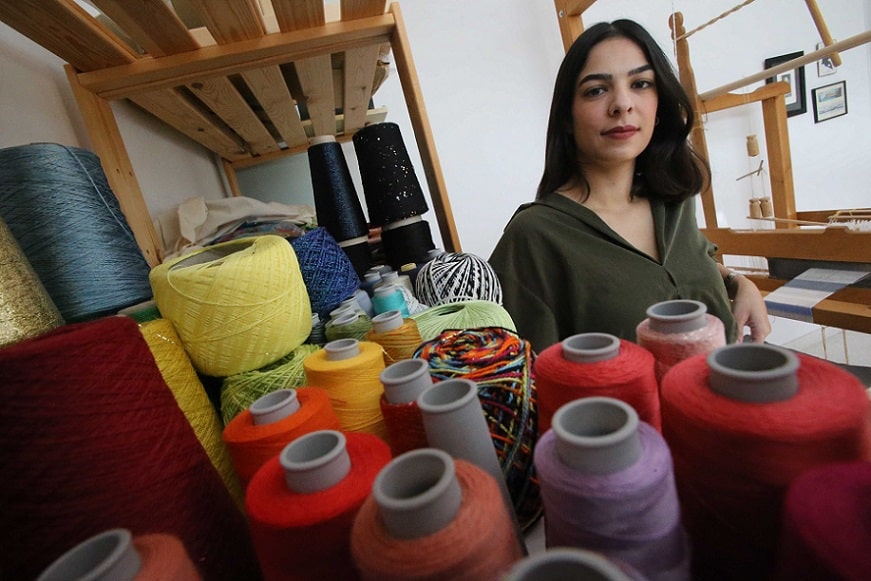There are many ways to put a loom to use. Melissa Heckers meets one creative breathing new life into a traditional Cyprus method by combining the art with modern wares
At 28, Katerina Efstratiou is surely the youngest traditional weaver in Cyprus. If not the youngest, she is certainly the most outspoken about the craft, and the need to continue what is one of the oldest handicrafts in the world.
“I believe that if something exists in a museum, there’s a reason,” she said from her studio in Ayioi Omologites in the centre of Nicosia. “But if you want to bring it to life, to use it, you have to manipulate and alter it a bit, find another, or better use for it; then you can keep it going, keep it alive”.
Efstratiou’s calling as a weaver wasn’t always clear, although she always had an affinity for the arts. “I took art lessons since I was a child, I always had a focus and an interest in art,” she said, “but I wasn’t sure which aspect of art I wanted to do, which path I wanted to take until I did a foundation course in art and design.
“You know that you’re creative, that you’re kind of an artist or a designer let’s say, but it’s quite difficult to find what perfectly suits you; the foundation was really helpful in guiding me.”
Following her foundation, Efstratiou continued her studies at Brighton University with a BA in 3D Design and Crafts. “(The degree) was an exploration of different materials, with workshops, crafts, a full hands-on thing,” she said. And it was when she took a module working with polymers that it dawned on her. “We worked with plastics and whatever comes from that material (polymer), and every time I took up a project, I always translated it to weaving; either I was incorporating threads into the projects or I used the weaving technique with plastics. That’s when I knew I had to get a master’s degree in textile design.” And so she did, with a specialisation in weaving.
Returning to the island in 2018, Efstratiou began to look for traditional Cypriot weaving. “I knew that it existed but I didn’t know how it worked. The image I had of Cypriot weaving was solely from museums. I began looking for traditional Cypriot weaving and its techniques because apparently we have several techniques”. Eventually, she found Phythkiotika weaving, a long-standing weaving style which is known for its signature patterns and vibrant colours, originally from the village of Fyti in Paphos, and practised on the island since the Louisianans ruled in Mediaeval times.
Listed as intangible Cultural Heritage by UNESCO, Efstratiou doesn’t only practice the Phythkiotiko style but teaches it both in private lessons in her studio, and at the education ministry’s Adult Education Centre. Having spent some time at the Cyprus Handicraft Centre, where traditional weavers passed on their knowhow, principles and techniques, she’s adamant to keep on passing down the art form.
“The sad thing it’s not involved in our everyday life because it’s difficult to find a usage for it. Traditionally, Phythkiotika were used as tea towels, table and TV doilies. We don’t use those anymore. My aim is to bring it back to our everyday life and find other ways for people to use it”.
But how? She’s changing the original Phythkiotiko colour pallet and motifs in her work. Showing me a scarf she has made that embodies the Phythkiotiko pattern and technique she said, “it’s a more simple design and the colours are not that bright; it’s just a very delicate, minimal design”. Efstratiou also makes bookmarks with the Phythkiotiko pattern and is seeking to make scatter cushions and everyday items that people would incorporate into their everyday life.
Though it originated in Paphos, Phythkiotika spread across the island. “You could find Phythkiotika all over Cyprus, in villages in Karpasia, in Larnaca,” Efstratiou said. But for her, now based in Nicosia, there are many reasons to keep the handicraft alive. “First of all because it’s in our culture and history and I think we have to be aware about that; I don’t know if everyone can find a usage for it, but we should at least know about it – most people have no idea nowadays, so I’m aiming to raise this awareness.
“But also because I’m Cypriot and I love Cyprus. I’m finding this as something that I can work with for my country and embody it in my practice,” she added.
Is it a dying art? “I think that’s quite a heavy thing to say but I can see it happening if someone doesn’t take off; that’s what I’m hoping to do, prevent it from dying through lessons and through my practice”.
Stressing the intricacies of the art, the difficult techniques and the need for space to work in, Efstratiou is passionate about the craft. “I believe that it’s therapeutic. When someone starts, I think it’s quite difficult for them to stop. You can leave it and go back to it, when you just want to be alone for a while and concentrate, it can be quite meditative,” she said.
For her personally, “you need discipline to practice weaving; there are some steps that you have to take to come to a result, and because I’m a creative but I’m also a very structurally minded, I need these steps and structure to keep a path. You have to thread the loom before you start, the steps are there to follow and then there’s what I feel while I’m weaving; you have to be calm to weave, so either it calms you down or you have to calm down so that you can weave”.
To learn more about Efstratiou’s work, visit: https://www.facebook.com/kefstratiou












Click here to change your cookie preferences